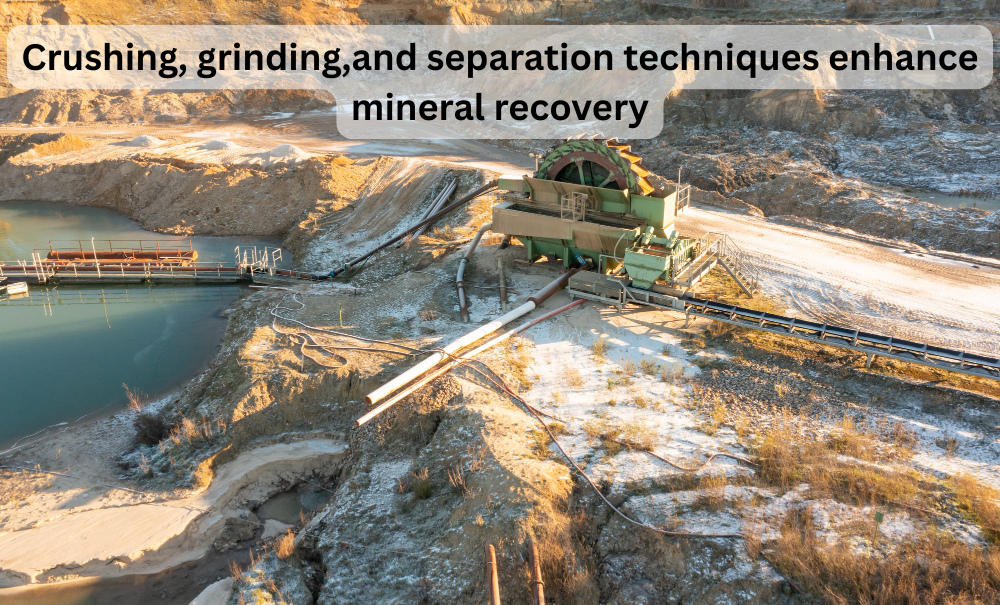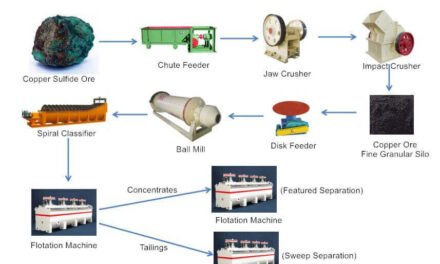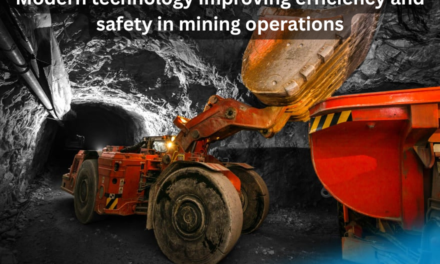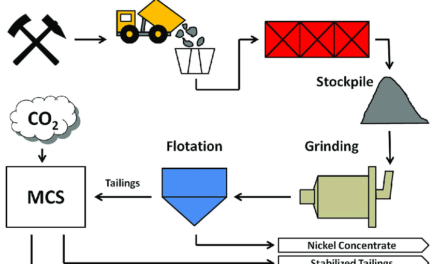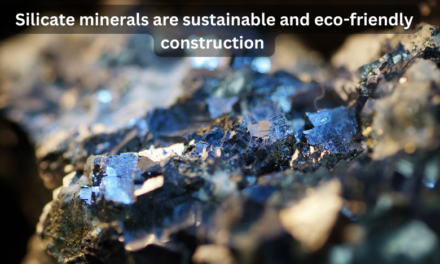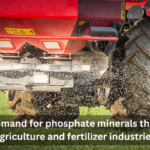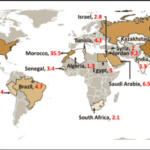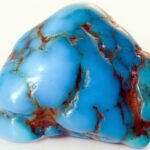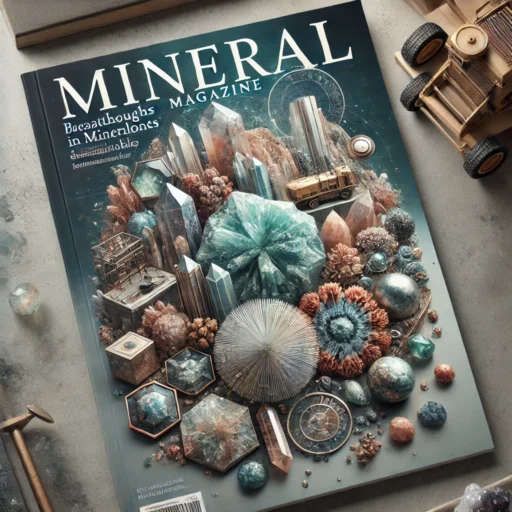Crushing, grinding, and separation are fundamental steps in mineral processing that enhance mineral recovery by increasing the efficiency with which valuable minerals are extracted from the ore. These techniques break down the ore, liberate valuable minerals, and concentrate them for further processing or sale. Here’s how each of these steps contributes to better mineral recovery:
1. Crushing: Reducing Ore Size and Liberating Minerals
Crushing is the first step in mineral processing and involves reducing the size of the ore. It is typically done in multiple stages, from primary to secondary and tertiary crushing, using various crushers like jaw crushers, cone crushers, and impact crushers.
- Liberation of valuable minerals: The primary purpose of crushing is to break the ore into smaller fragments, increasing the surface area for the next stage of processing. It is essential to crush the ore enough to liberate valuable minerals from the surrounding gangue (waste rock) but not excessively, as overly fine particles can make subsequent processing more difficult and costly.
- Size reduction: By reducing the size of the ore, it becomes easier to handle and transport. Additionally, smaller particles are easier to treat in subsequent stages like grinding and flotation, where fine particles are required to increase the efficiency of separation.
- Improved recovery: Properly crushed ore ensures that the valuable minerals are sufficiently exposed for separation in the next stages, increasing the overall recovery rates.
2. Grinding: Increasing Surface Area for Effective Separation
Grinding (or milling) is the process of reducing the size of the crushed ore to a finer particle size using grinding mills, such as ball mills, SAG mills, or rod mills.
- Increased liberation: The main goal of grinding is to further break down the particles so that the valuable minerals are fully liberated from the gangue. This step is critical for ensuring that mineral particles are separate and can be targeted during separation processes like flotation or gravity separation.
- Optimal particle size: For effective recovery, the ore must be ground to a specific size range. Too coarse a grind will result in low mineral liberation, while too fine a grind can cause excessive energy use, wear on grinding equipment, and loss of mineral content. Grinding to the correct particle size enhances the performance of downstream separation processes.
- Energy efficiency: Grinding is often the most energy-intensive part of the mineral processing workflow. Optimizing grinding operations (e.g., adjusting feed size or selecting appropriate grinding equipment) can help improve efficiency and recovery.
- Fine particles for flotation: In processes like froth flotation, finer particles are generally required for better recovery. The increased surface area of smaller particles allows more efficient attachment to flotation reagents, making flotation more effective in separating valuable minerals from gangue.
3. Separation Techniques: Extracting and Concentrating Valuable Minerals
After crushing and grinding, the material is subjected to various separation techniques that enhance mineral recovery by isolating valuable minerals from waste. The choice of separation method depends on the mineral properties, particle size, and ore characteristics. The main types of separation techniques include:
Gravity Separation
- Density differences: Gravity separation capitalizes on differences in density between valuable minerals and gangue. The ore is placed in a medium (water, air, or other) where the heavier valuable minerals will sink, and the lighter waste materials will float or be carried away.
- Techniques: Methods like shaking tables, jigs, spirals, and heavy media separation are used to concentrate minerals based on their density.
- Mineral recovery: Gravity separation is most effective for high-density minerals like gold, tin, and diamonds. It is also low-cost and energy-efficient, especially for coarse particles.
Froth Flotation
- Surface properties: Froth flotation is widely used for separating sulfide ores and other minerals with different surface properties. The process involves adding reagents to the slurry, which selectively make the valuable minerals hydrophobic (water-repellent), allowing them to attach to air bubbles and float to the surface.
- Efficiency: The flotation process is highly efficient for recovering minerals like copper, gold, zinc, lead, and nickel, which are typically found in finely ground ores. By selectively collecting the froth that contains the valuable minerals, flotation improves recovery rates significantly.
- Enhanced selectivity: Reagents (collectors, frothers, and modifiers) are tailored to improve the selectivity for specific minerals, increasing the recovery of targeted metals while minimizing losses.
Magnetic Separation
- Magnetic properties: Magnetic separation is used when minerals in the ore have different magnetic properties. The ore is passed through a magnetic field, and magnetic minerals are separated from non-magnetic ones.
- Techniques: Methods include low-intensity magnetic separation (LIMS) for weakly magnetic materials and high-intensity magnetic separation (HIMS) for stronger magnetic materials.
- Application: This technique is commonly used for ores containing minerals like magnetite, ilmenite, and hematite, and can significantly increase the recovery of magnetic minerals from the ore.
Leaching
- Chemical extraction: In cases where the ore is not easily separable through physical methods, chemical leaching is used. For example, cyanidation is commonly used to extract gold from its ore by dissolving the gold with cyanide solution.
- Increased recovery: Leaching is particularly useful for recovering precious metals like gold and copper that are locked in complex ores and can’t be separated efficiently by mechanical means.
- Selective extraction: By using different chemicals or pH conditions, leaching allows selective extraction of desired metals, improving recovery.
4. Concentration and Tailings Removal
Once the valuable minerals are separated, they are often concentrated to increase their purity and value. This may involve:
- Thickening: After separation, slurries are thickened to remove excess water and concentrate the material.
- Dewatering: Further dewatering (e.g., using centrifuges or filters) may be used to produce a dry concentrate that is easier to transport and process further.
- Tailings disposal: Waste material, called tailings, is separated and stored in tailings ponds or other waste management systems to minimize environmental impacts.
By concentrating the valuable minerals and removing the waste, the overall mineral recovery is significantly enhanced.
How These Techniques Improve Mineral Recovery
- Liberation of minerals: Crushing and grinding break the ore into smaller particles, allowing valuable minerals to be freed from surrounding waste, which is essential for effective separation.
- Increased efficiency: Advanced separation techniques (e.g., flotation, magnetic separation, gravity separation) can selectively target and concentrate valuable minerals, ensuring higher recovery rates. These processes increase the yield of high-quality products while minimizing waste and losses.
- Reduced losses: Effective size reduction (via crushing and grinding) ensures that valuable minerals are efficiently exposed and treated, reducing losses during the separation process.
- Optimized processing: The combination of crushing, grinding, and separation methods allows for the most effective treatment of ores with diverse properties, increasing the overall efficiency and profitability of the operation.
- Tailored methods for different ores: The ability to choose the right separation technique based on the mineral properties (e.g., magnetic, chemical, density) leads to higher recovery of valuable minerals from complex or low-grade ores.
Conclusion
Crushing, grinding, and separation techniques are integral to the mineral processing workflow, working together to liberate valuable minerals, concentrate them, and ensure their recovery in the final product. These steps increase the efficiency and effectiveness of mineral extraction, ultimately improving the profitability of mining operations and reducing the environmental impact of mining activities. By continuously improving these processes through technological advancements, mining companies can enhance recovery rates, reduce energy consumption, and optimize resource utilization.

